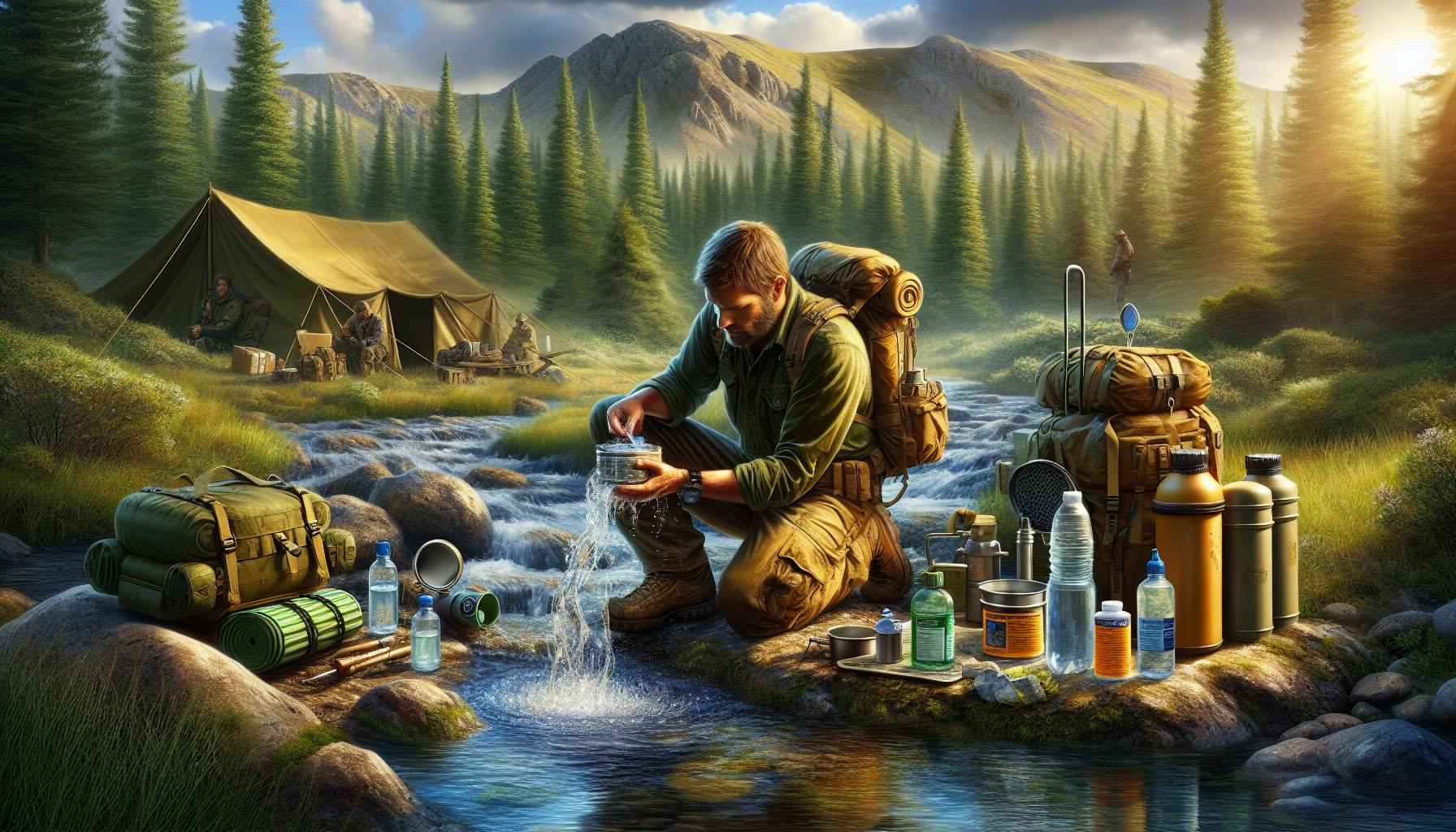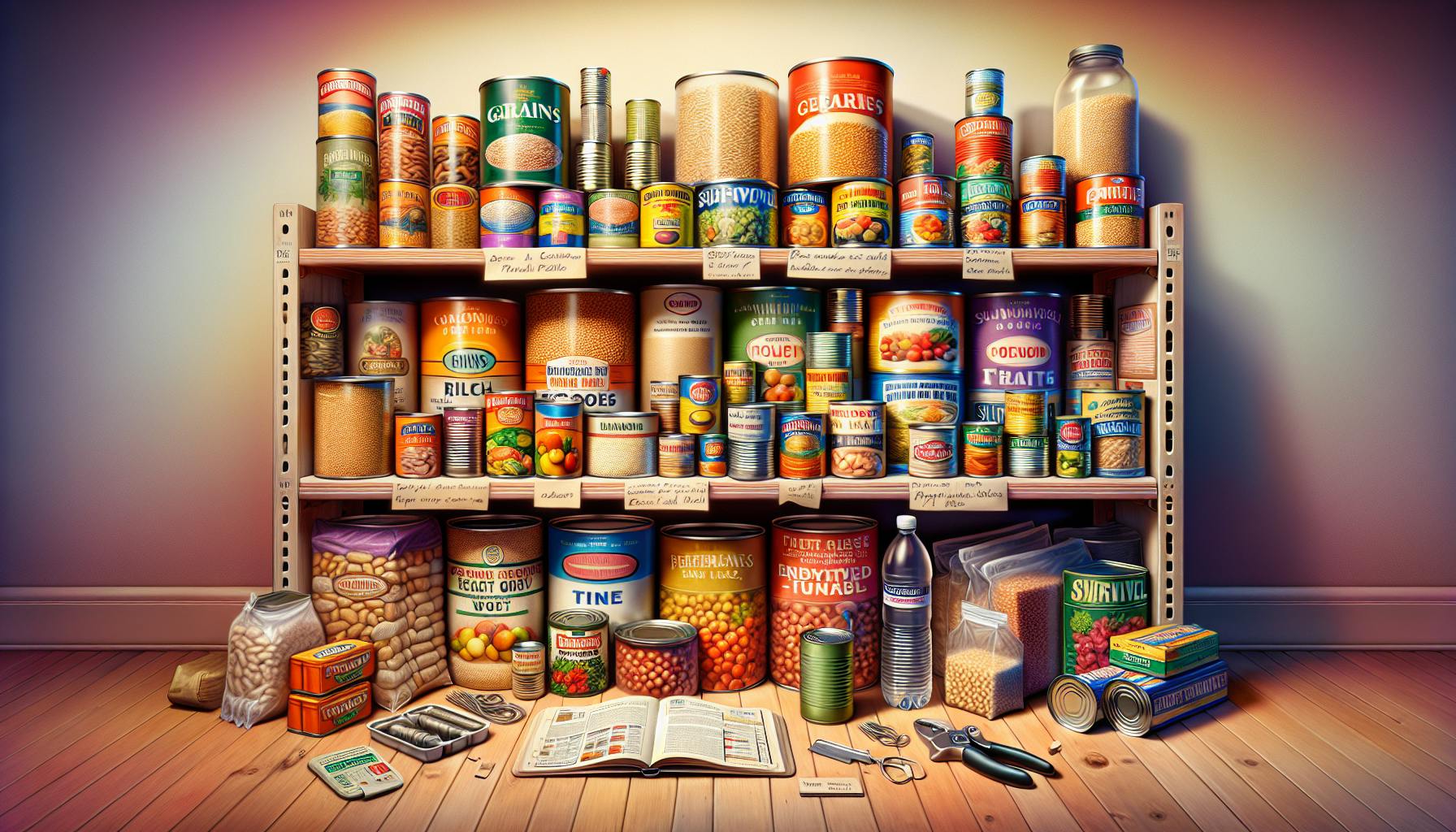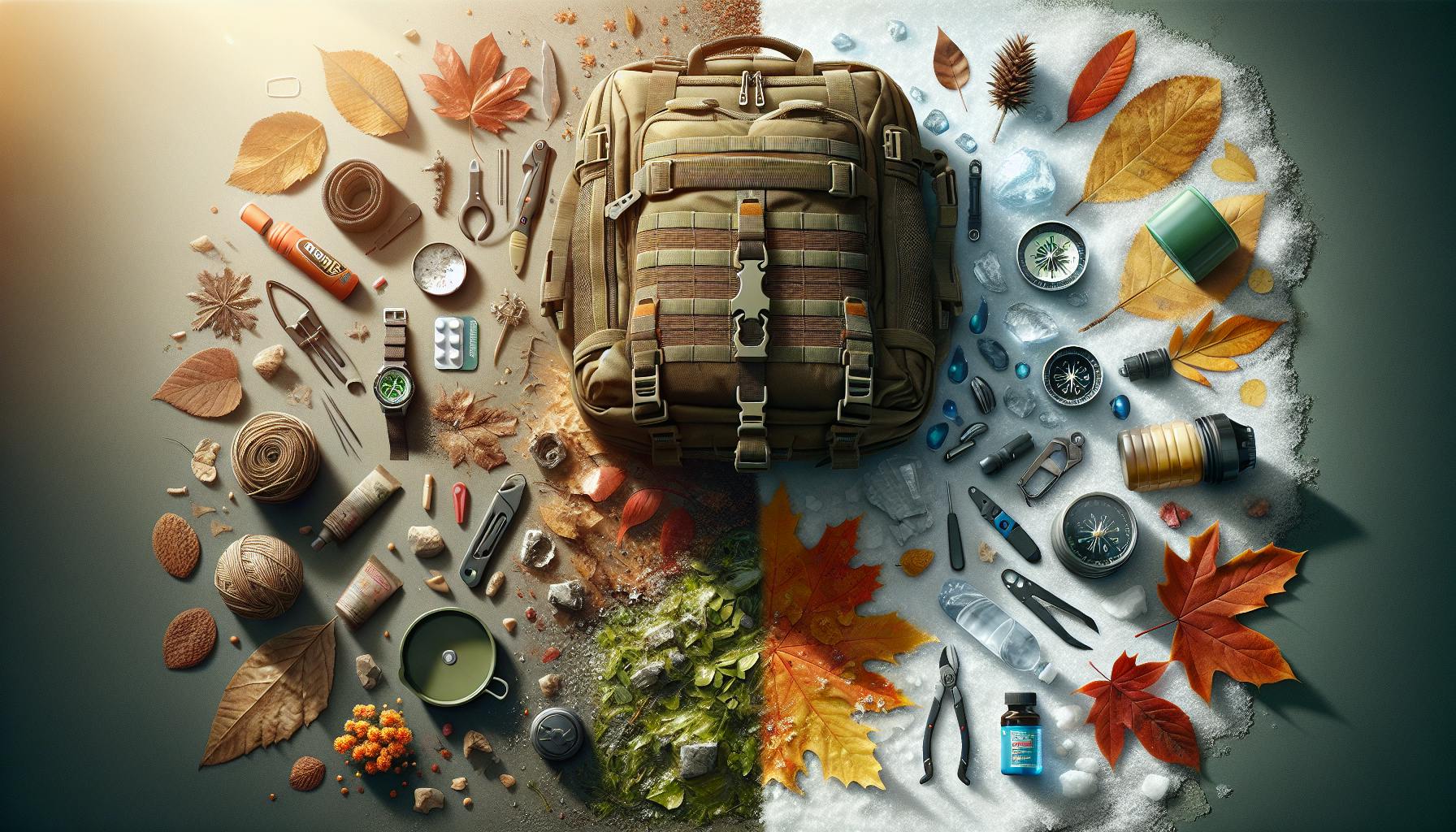When facing an emergency scenario, most would agree that having access to versatile and reliable gear can make a critical difference.
Equipping your survival kit with a durable, multipurpose tarp enables numerous lifesaving applications from storm shelter to water collection.
In this article, we'll explore the key features of an ideal survival tarp and provide an overview of vital emergency uses such as constructing protective shelters, harvesting rainwater, and more.
Introduction to Survival Tarps
A survival tarp is a versatile piece of emergency gear with many critical uses. This article will provide an overview of how to utilize a survival tarp for shelter, signaling, water collection, and more during a crisis.
Understanding the Versatility of a Survival Tarp
A survival tarp is designed to be extremely versatile in an emergency situation. Its lightweight, compact size makes it easy to pack while offering ample coverage when fully spread out. Key uses include:
- Shelter - Tarps can create effective temporary shelter from the elements, whether propped up with poles, tied between trees, or draped over debris for insulation. They protect against rain, wind, and sun exposure.
- Signaling - A tarp's visibility makes it useful for signaling rescuers, especially if made of reflective material. Tie a tarp between trees or wave it to attract attention.
- Water Collection - Use a tarp to collect rain water by staking it at an angle. The water runs off into a container below for drinking and washing.
- Shade - In hot climates, a tarp can provide life-saving shade from the harsh sun when suspended above the ground.
Having a multifunctional survival tarp prepares you for diverse critical needs in an emergency when resources are scarce.
Essential Features of a Waterproof Survival Tarp
When selecting a survival tarp, key features include:
- Durable, rip-stop fabric prevents tears and withstands long-term wear. Materials like vinyl coated polyester are waterproof and rugged.
- Reinforced edges maintain integrity when tying down or staking the tarp. Durable rope or webbing offers reliable anchoring.
- A silver reflective underside makes the tarp highly visible for signaling and provides heat retention for warmth.
- Lightweight tarps under 2 lbs are essential for portability and compact storage while remaining large enough for sufficient coverage.
- Waterproof construction like thermoplastic coatings provide critical protection from the elements during storms or wet conditions.
The Importance of Heavy Duty Survival Tarps
In emergency situations, a flimsy tarp won't withstand extreme wind, rainfall, and other harsh conditions. Investing in a heavy duty tarp offers:
- Durability to resist rips, leaks, and deterioration over long periods of time after quick temporary fixes are no longer sufficient.
- Stability with reinforced grommets and thick fabrics that won't flap excessively or collapse under strain and tension.
- Reliability even in the most extreme weather conditions and repeated use, providing mental ease knowing your shelter won't fail.
Though more costly, heavy duty survival tarps deliver the robustness and versatility so essential in crisis scenarios.
Reflective Survival Tarp for Emergencies
A reflective survival tarp provides benefits beyond a typical tarp:
- Visibility - The reflective surface attracts rescuers' attention for improved chance of being spotted and saved.
- Insulation - Reflective material traps body heat to keep you significantly warmer than a standard tarp in cold weather.
- Shade - It blocks sunlight preventing overheating and sun exposure risks in hot climates.
- Waterproofing – Aluminum reflective coating seals out moisture better than plain plastic tarps.
In an emergency situation, a reflective survival tarp could save your life by keeping you visible, shielded from elements, and warmer. It offers protection across more survival needs.
Multipurpose Uses Beyond Shelter
Beyond shelter and warmth, creative uses for a survival tarp include:
- A drop cloth for collecting rain water runoff.
- An emergency blanket wrapped around an injured person.
- A distress signal flag tied high within trees.
- A makeshift raft or sled to move equipment across snow or water.
- A wrap to cover and protect supplies from rain or dust.
Brainstorm all potential uses for a tarp in an emergency situation. Its versatility makes it one of the most valuable resources when in survival mode.
What is the best material for a survival tarp?
When selecting a survival tarp, durability and lightweight portability are key factors. Nylon tarps provide strength while remaining compact and easy to carry, making them a top choice for emergency preparedness.
Look for tarps made of ripstop nylon, which is reinforced to resist tearing even under strain. Silnylon is another good option - it is silicone-impregnated for enhanced water resistance. Avoid cheaper polyethylene plastic tarps - they deteriorate quicker over time.
Aim for a tarp that packs down small enough to stash in your go-bag or vehicle at all times. A good size is 8x10 ft - providing ample coverage without too much bulk. Consider handy features like grommets/tie-downs and reflective ripstop fabric to enhance shelter setup and visibility.
Leading brands like REI sell durable, packable nylon survival tarps built to hold up through storms and adverse conditions when you need protection the most. Invest in quality gear made for the extremes and test it out, so you know it works when called upon in an emergency.
Why is a tarp good for survival?
A tarp is an essential piece of survival gear because it provides versatile shelter and protection from the elements. Here are some of the key reasons a survival tarp is useful:
- Protection from rain, wind, snow: A tarp can be configured into a makeshift shelter, tent, or lean-to to get out of inclement weather. Even a compact tarp creates a dry space to escape storms.
- Water collection: By using a tarp as a rain catch, you can collect and store clean drinking water. This is crucial for survival when water sources may be contaminated.
- Shade from the sun: Getting out of the direct sun helps prevent dehydration, heat stroke, and sunburn. A tarp can provide life-saving shade.
- Signaling: A tarp can be used to create a visible distress signal for rescue teams. Some tarps even have a reflective, high-visibility side specifically for signaling purposes.
- Versatility: Tarps are lightweight, compact, and versatile. They have a variety of possible shelter configurations and other uses like ground cover, warmth retention, and gear protection.
Having a quality waterproof and durable survival tarp provides protection from the elements while also offering versatility for other critical survival needs like signaling, water collection, and shelter. It's an indispensable item for emergency preparedness kits.
Is a tent or tarp better for survival?
When it comes to survival preparedness, both tents and tarps have their advantages and disadvantages. Here's a quick comparison:
Portability
- Tarps are generally more lightweight and compact than tents. This makes them easier to carry in a bug out bag when you need to travel by foot. A basic 8x10 nylon tarp may weigh just 1-2 lbs.
- Tents provide more robust shelter but the extra fabric, poles, and stakes add bulk and weight. Backpacking tents still aim to be as lightweight as possible but are heavier than a tarp.
Weather Protection
- Tents form an enclosed structure that protects from wind, rain, snow. Some have waterproof flooring. This protects from the elements.
- Tarps need to be rigged creatively to make shelter. They provide overhead coverage but are open on the sides so wind can still get in.
Adaptability
- Tarps are extremely versatile for shelter. You can pitch them in different configurations, overhangs, and angles to suit the conditions.
- Tents are more constrained in shape. But some tents have convertible vestibules and rainflys to improve ventilation.
Overall, tarps make a smart survival choice for their portability and adaptability to different situations. But tents provide more robust, enclosed shelter from the elements. Choose based on your primary needs - weight savings or weather protection. And consider carrying an emergency tarp even if you already have a tent!
sbb-itb-b932644
What is the best long term tarp?
Vinyl tarps are often considered one of the most durable and long-lasting tarp materials. Made from polyvinyl chloride (PVC), vinyl tarps stand up well to extreme weather conditions and heavy use over time.
Here are some key benefits that make vinyl an excellent choice for a long term survival tarp:
- Weather Resistance - Vinyl tarps are waterproof and resistant to UV rays, mold, mildew, and abrasions. They can handle tough outdoor exposure while protecting you and your gear.
- Tear Strength - Industrial grade vinyl tarps have very high tear strength. Their reinforced weave makes them difficult to puncture or rip, even under strain.
- Flexibility - Vinyl tarps are pliable enough to conform to different shapes when used as a shelter or rain catch. Yet they still maintain their integrity without stretching out.
- Affordability - Relative to other long lasting tarp fabrics like canvas, vinyl tarps are very economical. You get great durability per dollar spent.
When selecting a survival tarp for long term use, look for 10-12 mil thick vinyl with nylon reinforcement and grommets every 2-3 feet. This heavy duty construction will provide reliable performance for years no matter what emergency situations arise. High quality vinyl tarps check all the boxes for durability, weather resistance, tear strength and flexibility over extended periods.
Selecting the Best Survival Tarp for Your Kit
Investing in a high quality tarp designed for ruggedness, visibility, and multi-functionality is key to emergency preparedness.
Criteria for Choosing the Best Survival Tarp
When selecting a survival tarp, prioritize durability, versatility, weight, and visibility. Look for tarps made from ripstop nylon or silicone coated nylon which resist tearing and withstand harsh weather. Choose a tarp that packs down small but offers multiple reinforced grommets for shelter configurations and tie downs. Opt for a bright color like orange with reflective accents to enhance visibility in low light.
Size and Shape: Tailoring to Your Needs
Determine how much coverage you need from your survival tarp based on planned usage. A 8x10 ft tarp offers ample area for 1-2 people. For larger groups or vehicle coverage, 10x12 ft to 12x12 ft works well. Consider a tapered or hexagonal shape for adding vestibules to your shelter.
Color and Reflectivity: Enhancing Visibility
Opt for a survival tarp in a high-visibility color like orange, yellow or green over plain blue or green. Reflective guy lines and perimeter marker tabs also aid visibility at night or in low light conditions.
Reinforced Grommets and Edges: Ensuring Longevity
Look for double stitched, reinforced grommets at regular intervals around the tarp. Reinforced perimeter edges prevent ripping or fraying even in high winds. Both features enhance durability for long-term use.
Portability: Packing a Lightweight Survival Tarp
Look for survival tarps that weigh 1-2 lbs and pack down small for easy transport in a bug out bag. Some models come with compression straps or attached stuff sacks to minimize packed size. Silnylon material and ripstop nylon offer strength and lightness.
Constructing a Survival Tarp Shelter
A survival tarp can be an invaluable tool when building an emergency shelter. With some basic knowledge of shelter construction techniques, a tarp allows you to create stable, weatherproof refuge in various environments.
Basic Shelter Configurations
Some simple yet effective survival shelter designs using a tarp include:
- A-frame - Drive a ridgeline between two trees or posts, drape the tarp over it, and stake down the sides. Provides good rain runoff.
- Lean-to - Tie one end of the ridgeline to a tree or post, slope the tarp to the ground, and stake the other end. Simple and fast to construct.
- Emergency bivvy - Use paracord to fashion the tarp into a cocoon shape around your sleeping area when no other shelter materials are available.
Getting the fundamentals right is key - be sure to angle the structure away from the wind and seal any gaps.
Advanced Shelter Techniques
More complex structures are possible for experienced survivalists:
- Connect multiple tarps together for a larger covered area.
- Build an enclosed structure with cube or dome shapes by securing the tarps to several posts or trees.
- Use found materials like logs or brush to provide additional structural support and insulation.
Take care not to damage the tarp when lashing or tying it to natural supports.
Weatherproofing Your Shelter
To improve water resistance and wind proofing:
- Dig shallow trenches around the shelter to divert rain runoff.
- Weigh down the edges with heavy objects like rocks or logs.
- Use nearby vegetation like pine boughs to plug gaps and provide extra sealing.
A survival tarp alone blocks about 80% of wind and rain - a few enhancements can make it even more protective.
Utilizing Natural Resources
Incorporate any available natural materials:
- Pine needles and leaves make excellent insulating ground cover inside the shelter.
- Twigs and brush can be woven through the tarp grommets to firmly anchor it.
- Rocks are great for weighing down the edges and corners of the tarp.
Taking advantage of nature's provisions boosts the stability and comfort of a survival tarp shelter.
Emergency Repairs in the Field
If your tarp shelter becomes compromised:
- Duct tape can quickly patch small punctures and holes.
- Extra paracord allows you to re-tie or reinforce tie-down points as needed.
- Sticks and sap can temporarily seal cracks or fasten broken grommets.
Carrying a few key repair items extends the usable lifespan of your survival tarp in an emergency situation.
Harnessing a Survival Tarp for Water Collection
Maximizing the use of a survival tarp to secure a vital resource: water.
Rainwater Harvesting Techniques
Collecting rainwater with a waterproof survival tarp can be a great way to secure clean drinking water in an emergency situation. Here are some effective techniques:
- Create a simple A-frame shelter using a rope and stakes to angle the tarp to funnel rainwater into containers placed underneath the center point of the A-frame. This is one of the easiest methods. - Use a grommeted tarp stretched between trees or poles to form a catchment area. Place buckets under the edges of the tarp to collect the rain as it rolls off. - Dig a small trench under the middle of the tarp and place a container in the trench to gather water dripping from the center of the tarp. - For maximum yield, choose a tarp material with a reflective upper side so condensation forms on the underside for collection.
Dew Collection with a Survival Tarp
In addition to rainwater, a heavy duty survival tarp can help collect morning dew as a supplementary emergency water source:
- Place absorbent cloth underneath the edges of the tarp overnight to soak up dew that forms on the surface. Wring water from the cloth in the morning. - Tilt one end of the tarp to an angle to make dew run off into a container rather than soak into the ground.
Purification and Storage Solutions
To safely consume tarp-collected water:
- Use water purification tablets, bleach (8 drops per gallon), or boil for 1 minute.
- Store water in sealed containers in cool, dark place to prevent algae growth. Replace every 6 months.
Optimizing Tarp Placement for Maximum Yield
- Face broad side of tarp perpendicular to prevailing winds to catch blowing rain.
- Tilt tarp at angle to encourage water runoff into collection containers.
- Place in sunny area to maximize evaporation and overnight dew formation.
Innovative Water Collection Setups
Some unique solutions for gathering water with a tarp include:
- Dig trench under tarp to channel water from the middle into a container placed at the end of the trench.
- Use multiple tarps at different angles arranged in sequence to facilitate water flow into central collection points.
- Suspend tarp between trees and place absorbent cloth underneath to soak up moisture that condenses on the underside of the tarp overnight.
Conclusion
A quality survival tarp is an essential piece of emergency preparedness gear with many critical uses. When properly set up, a survival tarp can provide lifesaving shelter, collect rainwater, signal rescuers, and more.
Here are some key ways to utilize a survival tarp in an emergency:
- Shelter - Tarps can create waterproof overhead cover or tent-like shelters. Choose durable, waterproof tarps rated for outdoor use. Pitch using trees, poles, ropes, and stakes. Create shade from the sun or insulation from the cold.
- Water Collection - Use tarps to collect rainwater or morning dew. Secure tarps at an angle to drain water into containers. Ensure water collection methods are safe and free of contaminants. Boil water before drinking.
- Signaling - A tarp's visibility attracts rescuers' attention. Hang tarps between trees or spread on the ground in open areas. Choose bright colors like orange or yellow. Reflective survival tarps are ideal.
When prepping for disasters, study proper techniques to rig tarps for shelter, signaling, and other uses. Stock durable waterproof survival tarps and cordage to utilize this versatile survival gear during emergencies.


